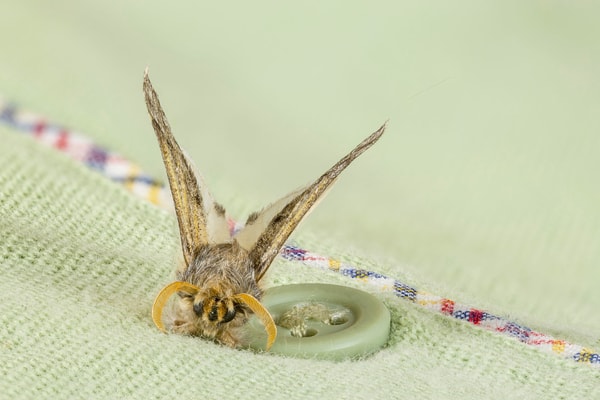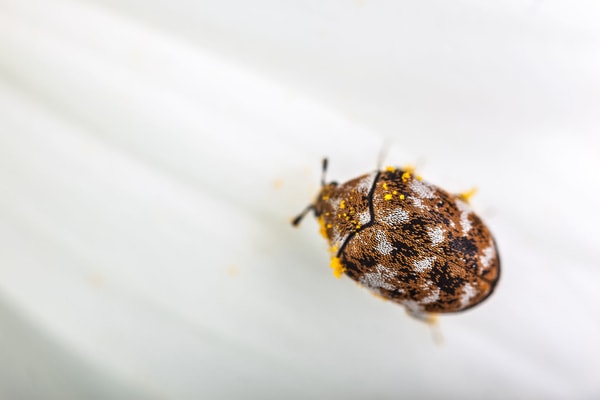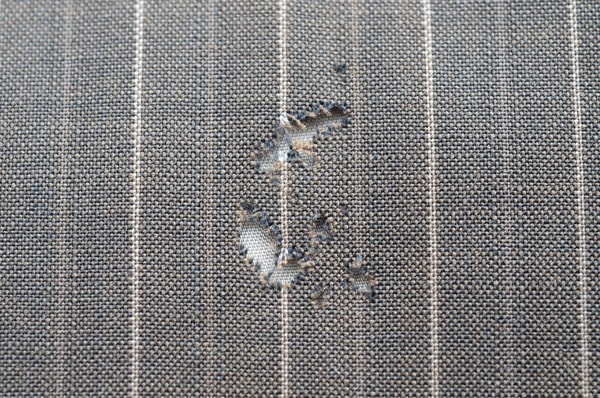Cleaning closets often leads to organizing clothes and other belongings. Just as important, however, is to remove those pesky bugs that eat clothes. By the time you see signs of your clothes being damaged by bugs, it is often too late.

If this sounds like your worst nightmare, don’t panic. This article will help you identify some of the types of insects that eat clothes and tell you how to help prevent fabric-eating bugs from invading your home.
Bugs That Eat Clothes
Clothes Moths
- Moths come to mind most frequently when we think of fabric-eating bugs. Adult moths do not actually eat clothing, but they do deposit eggs that turn into hungry larvae.
- They typically prefer to eat animal-based materials, such as silk, wool and leather. They have also been known to consume fabric blends and clothing that has been stained with food.
Carpet Beetles

- Adult carpet beetles typically only live for 20 to 60 days and can lay up to 100 eggs, which take only a week or two to hatch into larvae that can be present for up to a year.
- Adult beetles look similar to ladybugs, but much smaller, and will also eat the flower pollen found in gardens.
Where Do Bugs That Eat Clothes Hide?
Bugs that eat clothes do not like to hide in items that you frequently use. They prefer to feast undisturbed. You can find both clothes moths and carpet beetles in some of the following places:
- Stored clothing in closets or boxes that has not been used in a long time
- Hanging wall textiles that are less frequently vacuumed or cleaned
- Carpet along the wall that is harder to vacuum (this is more likely if the carpet is older as modern carpet is generally made of polyester type materials that carpet beetles will generally not feed on)
- Attics and trunks
- Dressers, especially along their back corners
- In carpeted areas under furniture
How to Help Prevent Bugs That Eat Clothes
An effective way to help prevent an infestation of fabric-eating bugs (including cotton-eating insects and bugs that eat wool) is by paying close attention to the places they like to hide. Be sure to vacuum carpets, rugs, tapestry wall hangings and upholstered furniture thoroughly to help remove any larvae.
Inspect your heirloom clothing regularly, as well as clothing that's stored and items you don’t often wear. Make sure the area where you store clothing stays as clean as possible, whether it's a trunk, attic or closet. Vacuum the entire space and wipe down all shelves and walls regularly.

Also, make sure to keep clothes clean and remove any stains on clothing that could attract hungry pests before putting them in storage.
What To Do In Case of An Infestation
Once fabric-eating insects have infested your home, remove any items that have been damaged from your wardrobe. Be sure to wash or dry clean each item as manufacturer’s instructions allow. As you remove and launder damaged items, be careful to also isolate them so there's no contamination in other parts of your home. If you decide to dispose of damaged fabrics, seal them in plastic bags before putting them in the garbage to help prevent insects from emerging and laying more eggs in your home.
If the infestation is large or if you need additional assistance to help remove the pests completely, contact the pest control professionals at Terminix® for help.



